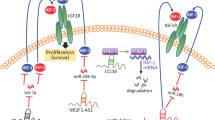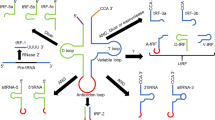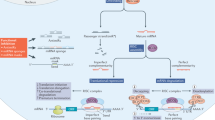Abstract
The capacity of tiny, noncoding RNA molecules (including small, interfering RNA molecules and micro-RNA molecules [miRNAs]) to control gene expression in a very specific and efficient manner has opened new avenues in biomedical research. RNA interference (RNAi) is now an important tool able to specifically inhibit the expression of almost any gene. The understanding of the molecular determinants of endocrine diseases has benefited a great deal from the new opportunities offered by the use of RNAi. Because RNAi is able to specifically inhibit the expression of particular genes it has great therapeutic potential, and the first clinical trials have already started. The delivery of RNAi in vivo, however, requires different methods to those used in vitro. RNAi uses several components of a cellular pathway devoted to the production of miRNAs, a class of naturally occurring small, noncoding RNA molecules that function as translational repressors. There is growing evidence that miRNAs play key regulatory roles in several cellular processes, such as proliferation, differentiation and apoptosis, and recent publications have demonstrated that alterations in miRNA function might be involved in endocrine diseases, including diabetes mellitus, and in endocrine cancer.
Key Points
-
Both small, interfering RNA and its naturally occurring counterpart micro-RNA are important tools in biomedical research
-
Many therapeutic targets for endocrine disease have been identified using RNA interference
-
Design and delivery methods are very important for the efficiency of small, interfering RNA molecules
-
Micro-RNA molecules are involved in endocrine function and disease
-
Micro-RNA molecules are very attractive therapeutic targets because they are involved in a variety of important processes
This is a preview of subscription content, access via your institution
Access options
Subscribe to this journal
Receive 12 print issues and online access
$209.00 per year
only $17.42 per issue
Buy this article
- Purchase on Springer Link
- Instant access to full article PDF
Prices may be subject to local taxes which are calculated during checkout

Similar content being viewed by others
References
Fire A et al. (1998) Potent and specific genetic interference by double-stranded RNA in Caenorhabditis elegans. Nature 391: 806–811
Elbashir SM et al. (2001) Duplexes of 21-nucleotide RNAs mediate RNA interference in cultured mammalian cells. Nature 411: 494–498
Novina CD and Sharp PA (2004) The RNAi revolution. Nature 430: 161–164
Cai X et al. (2004) Human microRNAs are processed from capped, polyadenylated transcripts that can also function as mRNAs. RNA 10: 1957–1966
Lee Y et al. (2004) MicroRNA genes are transcribed by RNA polymerase II. EMBO J 23: 4051–4060
Lee Y et al. (2003) The nuclear RNase III Drosha initiates microRNA processing. Nature 425: 415–419
Yi R et al. (2003) Exportin-5 mediates the nuclear export of pre-microRNAs and short hairpin RNAs. Genes Dev 17: 3011–3016
Lund E et al. (2004) Nuclear export of microRNA precursors. Science 303: 95–98
Ambros V (2004) The functions of animal microRNAs. Nature 431: 350–355
Bartel DP (2004) MicroRNAs: genomics, biogenesis, mechanism, and function. Cell 116: 281–297
Bagga S et al. (2005) Regulation by let-7 and lin-4 miRNAs results in target mRNA degradation. Cell 122: 553–563
Wu L et al. (2006) MicroRNAs direct rapid deadenylation of mRNA. Proc Natl Acad Sci U S A 103: 4034–4039
Doench JG and Sharp PA (2004) Specificity of microRNA target selection in translational repression. Genes Dev 18: 504–511
Petersen CP et al. (2006) Short RNAs repress translation after initiation in mammalian cells. Mol Cell 21: 533–542
Pillai RS et al. (2007) Repression of protein synthesis by miRNAs: how many mechanisms? Trends Cell Biol 17: 118–126
Mathonnet G et al. (2007) MicroRNA inhibition of translation initiation in vitro by targeting the Cap-binding complex eIF4F. Science 317: 1764–1767
Griffiths-Jones S et al. (2005) Rfam: annotating non-coding RNAs in complete genomes. Nucleic Acids Res 33: D121–D124
Gong H et al. (2005) The role of small RNAs in human diseases: potential troublemaker and therapeutic tools. Med Res Rev 25: 361–381
Lu J et al. (2005) MicroRNA expression profiles classify human cancers. Nature 435: 834–838
Voorhoeve PM et al. (2006) A genetic screen implicates miRNA-372 and miRNA-373 as oncogenes in testicular germ cell tumors. Cell 124: 1169–1181
Bottoni A et al. (2005) miR-15a and miR-16-1 down-regulation in pituitary adenomas. J Cell Physiol 204: 280–285
Fan X et al. (2001) Gain of chromosome 3 and loss of 13q are frequent alterations in pituitary adenomas. Cancer Genet Cytogenet 128: 97–103
Roldo C et al. (2006) MicroRNA expression abnormalities in pancreatic endocrine and acinar tumors are associated with distinctive pathologic features and clinical behavior. J Clin Oncol 24: 4677–4684
He H et al. (2005) The role of microRNA genes in papillary thyroid carcinoma. Proc Natl Acad Sci U S A 102: 19075–19080
Kitamura Y and Hirotab S (2004) Kit as a human oncogenic tyrosine kinase. Cell Mol Life Sci 61: 2924–2931
Esau C et al. (2004) MicroRNA-143 regulates adipocyte differentiation. J Biol Chem 279: 52361–52365
Poy MN et al. (2004) A pancreatic islet-specific microRNA regulates insulin secretion. Nature 432: 226–230
Plaisance V et al. (2006) MicroRNA-9 controls the expression of granuphilin/Slp4 and the secretory response of insulin-producing cells. J Biol Chem 281: 26932–26942
Baroukh N et al. (2007) MicroRNA-124a regulates Foxa2 expression and intracellular signaling in pancreatic β-cell lines. J Biol Chem 282: 19575–19588
He A et al. (2007) Over-expression of miR-29, highly upregulated in diabetic rats, leads to insulin resistance in 3T3-L1 adipocytes. Mol Endocrinol [doi: 10.1210/me.2007-0167]
Esau C et al. (2006) miR-122 regulation of lipid metabolism revealed by in vivo antisense targeting. Cell Metab 3: 87–98
Xing M (2005) BRAF mutation in thyroid cancer. Endocr Relat Cancer 12: 245–262
Salvatore G et al. (2006) BRAF is a therapeutic target in aggressive thyroid carcinoma. Clin Cancer Res 12: 1623–1629
Kodama Y et al. (2005) The RET proto-oncogene: a molecular therapeutic target in thyroid cancer. Cancer Sci 96: 143–148
Berns K et al. (2004) A large-scale RNAi screen in human cells identifies new components of the p53 pathway. Nature 428: 431–437
Paddison PJ et al. (2004) A resource for large-scale RNA-interference-based screens in mammals. Nature 428: 427–431
Kolfschoten IG et al. (2005) A genetic screen identifies PITX1 as a suppressor of RAS activity and tumorigenicity. Cell 121: 849–858
Westbrook TF et al. (2005) A genetic screen for candidate tumor suppressors identifies REST. Cell 121: 837–848
Tang X et al. (2006) An RNA interference-based screen identifies MAP4K4/NIK as a negative regulator of PPARγ, adipogenesis, and insulin-responsive hexose transport. Proc Natl Acad Sci U S A 103: 2087–2092
Abel ED et al. (2001) Adipose-selective targeting of the GLUT4 gene impairs insulin action in muscle and liver. Nature 409: 729–733
Taniguchi CM et al. (2005) Complementary roles of IRS-1 and IRS-2 in the hepatic regulation of metabolism. J Clin Invest 115: 718–727
Koo SH et al. (2004) PGC-1 promotes insulin resistance in liver through PPAR-α-dependent induction of TRB-3. Nat Med 10: 530–534
Cho CY et al. (2006) Identification of the tyrosine phosphatase PTP-MEG2 as an antagonist of hepatic insulin signaling. Cell Metab 3: 367–378
Song E et al. (2003) RNA interference targeting Fas protects mice from fulminant hepatitis. Nat Med 9: 347–351
Hamar P et al. (2004) Small interfering RNA targeting Fas protects mice against renal ischemia-reperfusion injury. Proc Natl Acad Sci U S A 101: 14883–14888
Bradley SP et al. (2005) Gene silencing in the endocrine pancreas mediated by short-interfering RNA. Pancreas 31: 373–379
Morrissey DV et al. (2005) Potent and persistent in vivo anti-HBV activity of chemically modified siRNAs. Nat Biotechnol 23: 1002–1007
Urban-Klein B et al. (2005) RNAi-mediated gene-targeting through systemic application of polyethylenimine (PEI)-complexed siRNA in vivo. Gene Ther 12: 461–466
Hu-Lieskovan S et al. (2005) Sequence-specific knockdown of EWS-FLI1 by targeted, nonviral delivery of small interfering RNA inhibits tumor growth in a murine model of metastatic Ewing's sarcoma. Cancer Res 65: 8984–8992
Soutschek J et al. (2004) Therapeutic silencing of an endogenous gene by systemic administration of modified siRNAs. Nature 432: 173–178
Zimmermann TS et al. (2006) RNAi-mediated gene silencing in non-human primates. Nature 441: 111–114
Kumar P et al. (2007) Transvascular delivery of small interfering RNA to the central nervous system. Nature 448: 39–43
Song E et al. (2005) Antibody mediated in vivo delivery of small interfering RNAs via cell-surface receptors. Nat Biotechnol 23: 709–717
Williams BR (1999) PKR; a sentinel kinase for cellular stress. Oncogene 18: 6112–6120
Sledz CA et al. (2003) Activation of the interferon system by short-interfering RNAs. Nat Cell Biol 5: 834–839
Judge AD et al. (2005) Sequence-dependent stimulation of the mammalian innate immune response by synthetic siRNA. Nat Biotechnol 23: 457–462
Hornung V et al. (2005) Sequence-specific potent induction of IFN-α by short interfering RNA in plasmacytoid dendritic cells through TLR7. Nat Med 11: 263–270
Kim DH et al. (2004) Interferon induction by siRNAs and ssRNAs synthesized by phage polymerase. Nat Biotechnol 22: 321–325
Persengiev SP et al. (2004) Nonspecific, concentration-dependent stimulation and repression of mammalian gene expression by small interfering RNAs (siRNAs). RNA 10: 12–18
Ma Z et al. (2005) Cationic lipids enhance siRNA-mediated interferon response in mice. Biochem Biophys Res Commun 330: 755–759
Saxena S et al. (2003) Small RNAs with imperfect match to endogenous mRNA repress translation. Implications for off-target activity of small inhibitory RNA in mammalian cells. J Biol Chem 278: 44312–44319
Hutvagner G et al. (2004) Sequence-specific inhibition of small RNA function. PLoS Biol 2: e98
Meister G et al. (2004) Sequence-specific inhibition of microRNA- and siRNA-induced RNA silencing. RNA 10: 544–550
Krutzfeldt J et al. (2005) Silencing of microRNAs in vivo with 'antagomirs'. Nature 438: 685–689
Check E (2005) A crucial test. Nat Med 11: 243–244
McFarland TJ et al. (2004) Gene therapy for proliferative ocular diseases. Expert Opin Biol Ther 4: 1053–1058
Bitko V et al. (2005) Inhibition of respiratory viruses by nasally administered siRNA. Nat Med 11: 50–55
Parikh H et al. (2007) TXNIP regulates peripheral glucose metabolism in humans. PLoS Med 4: e158
Haasch D et al. (2006) PKCθ is a key player in the development of insulin resistance. Biochem Biophys Res Commun 343: 361–368
Sajan MP et al. (2006) Repletion of atypical protein kinase C following RNA interference-mediated depletion restores insulin-stimulated glucose transport. J Biol Chem 281: 17466–17473
Akpinar P et al. (2005) Tmem27: a cleaved and shed plasma membrane protein that stimulates pancreatic β cell proliferation. Cell Metab 2: 385–397
Schisler JC et al. (2005) The Nkx6.1 homeodomain transcription factor suppresses glucagon expression and regulates glucose-stimulated insulin secretion in islet β cells. Proc Natl Acad Sci U S A 102: 7297–7302
Garnett KE et al. (2005) Differential gene expression between Zucker fatty rats and Zucker diabetic fatty rats: a potential role for the immediate-early gene Egr-1 in regulation of β cell proliferation. J Mol Endocrinol 35: 13–25
Katayama K et al. (2004) RNA interfering approach for clarifying the PPARγ pathway using lentiviral vector expressing short hairpin RNA. FEBS Lett 560: 178–182
Zhou QL et al. (2004) Analysis of insulin signalling by RNAi-based gene silencing. Biochem Soc Trans 32: 817–821
Diaferia G et al. (2004) RNA-mediated interference indicates that SEL1L plays a role in pancreatic β-cell growth. DNA Cell Biol 23: 510–518
Jiang ZY et al. (2003) Insulin signaling through Akt/protein kinase B analyzed by small interfering RNA-mediated gene silencing. Proc Natl Acad Sci USA 100: 7569–7574
Waselle L et al. (2003) Involvement of the Rab27 binding protein Slac2c/MyRIP in insulin exocytosis. Mol Biol Cell 14: 4103–4113
Zablewska B et al. (2003) Transcription regulation of the multiple endocrine neoplasia type 1 gene in human and mouse. J Clin Endocrinol Metab 88: 3845–3851
Yart A et al. (2005) The HRPT2 tumor suppressor gene product parafibromin associates with human PAF1 and RNA polymerase II. Mol Cell Biol 25: 5052–5060
Riss D et al. (2003) Differential expression of galectin-3 in pituitary tumors. Cancer Res 63: 2251–2255
Shi Y et al. (2006) Ribonucleic acid interference targeting S100A4 (Mts1) suppresses tumor growth and metastasis of anaplastic thyroid carcinoma in a mouse model. J Clin Endocrinol Metab 91: 2373–2379
Sorrentino R et al. (2005) Aurora B overexpression associates with the thyroid carcinoma undifferentiated phenotype and is required for thyroid carcinoma cell proliferation. J Clin Endocrinol Metab 90: 928–935
Author information
Authors and Affiliations
Corresponding author
Ethics declarations
Competing interests
The authors declare no competing financial interests.
Rights and permissions
About this article
Cite this article
Kolfschoten, I., Regazzi, R. Technology Insight: small, noncoding RNA molecules as tools to study and treat endocrine diseases. Nat Rev Endocrinol 3, 827–834 (2007). https://doi.org/10.1038/ncpendmet0674
Received:
Accepted:
Issue Date:
DOI: https://doi.org/10.1038/ncpendmet0674



